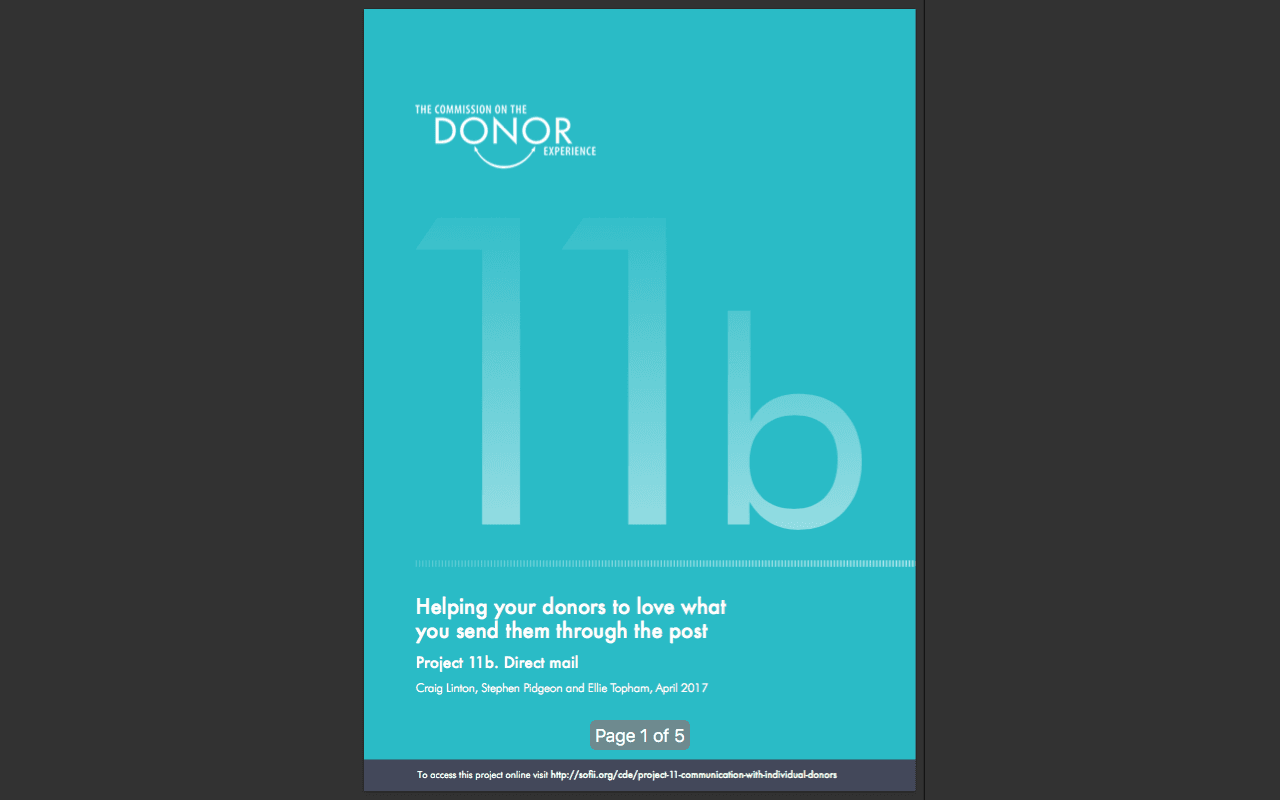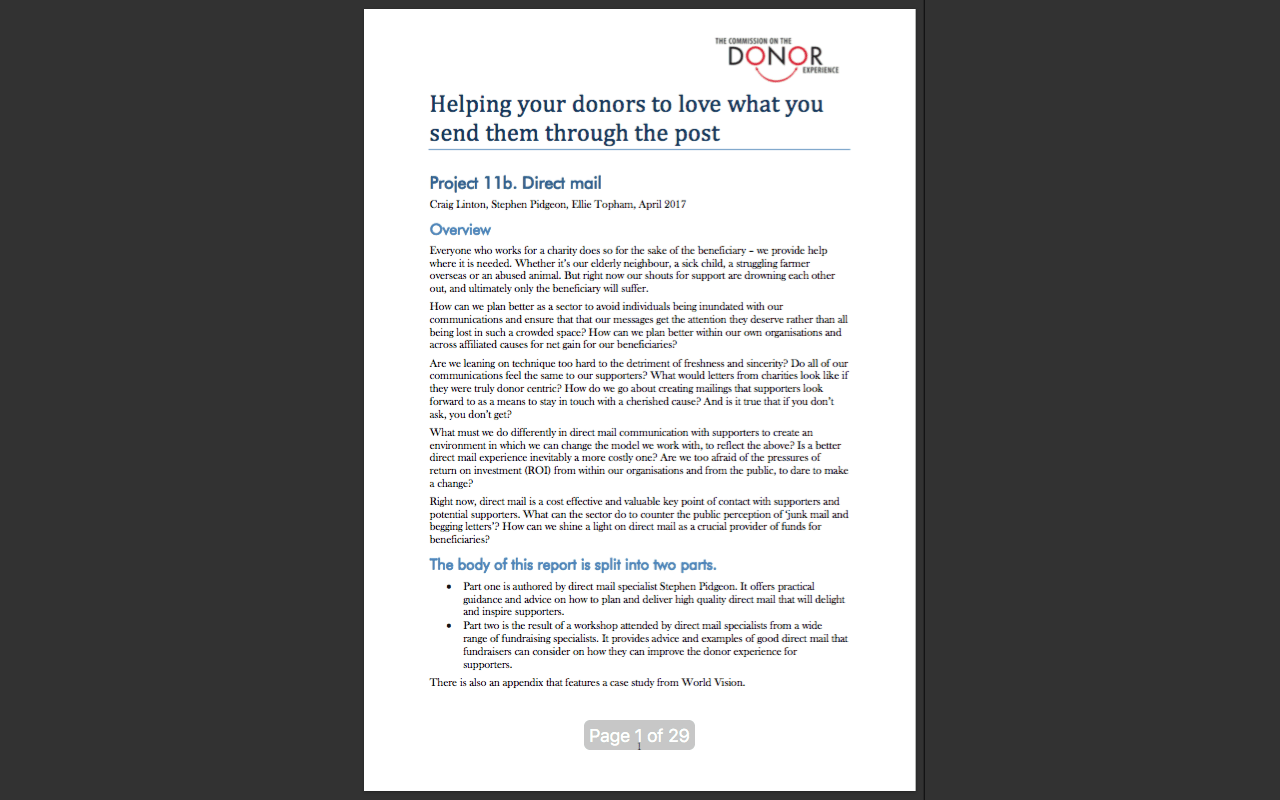CDE project 11b summary: direct mail
- Written by
- The Commission on the Donor Experience
- Added
- April 29, 2017
Project 11b. Direct mail
Helping your donors to love what you send them through the post
Craig Linton, Stephen Pidgeon, Ellie Topham, April 2017


Overview
Everyone who works for a charity does so for the sake of the beneficiary – we provide help where it is needed. Whether it’s our elderly neighbour, a sick child, a struggling farmer overseas or an abused animal. But right now our shouts for support are drowning each other out, and ultimately only the beneficiary will suffer.
How can we plan better as a sector to avoid individuals being inundated with our communications and ensure that that our messages get the attention they deserve rather than all being lost in such a crowded space? How can we plan better within our own organisations and across affiliated causes for net gain for our beneficiaries?
Are we leaning on technique too hard to the detriment of freshness and sincerity? Do all of our communications feel the same to our supporters? What would letters from charities look like if they were truly donor centric? How do we go about creating mailings that supporters look forward to as a means to stay in touch with a cherished cause? And is it true that if you don’t ask, you don’t get?
What must we do differently in direct mail communication with supporters to create an environment in which we can change the model we work with, to reflect the above? Is a better direct mail experience inevitably a more costly one? Are we too afraid of the pressures of return on investment (ROI) from within our organisations and from the public, to dare to make a change?
Right now, direct mail is a cost effective and valuable key point of contact with supporters and potential supporters. What can the sector do to counter the public perception of ‘junk mail and begging letters’? How can we shine a light on direct mail as a crucial provider of funds for beneficiaries?
The body of this report is split into two parts.
- Part one is authored by direct mail specialist Stephen Pidgeon. It offers practical guidance and advice on how to plan and deliver high quality direct mail that will delight and inspire supporters.
- Part two is the result of a workshop attended by direct mail specialists from a wide range of fundraising specialists. It provides advice and examples of good direct mail that fundraisers can consider on how they can improve the donor experience for supporters.
There is also an appendix that features a case study from World Vision.
Summary recommendations
1. Understand direct mail and its role in the wider organisational and fundraising strategy
Direct mail is arguably the most tested form of fundraising. There is over a century of evidence of what works and doesn’t. A good starting point is: http://sofii.org/the-main-areas-of-fundraising/dm-door-drops-and-household-deliveries. Understand the ‘rules’ that exist and use these to deliver inspiring mail to supporters.
However, rules are there to be broken and if overused then the impact can be diminished. For example, the original Amnesty International pen pack (see http://sofii.org/case-study/amnesty-international-the-pen-pack) was a powerful appeal about torture. The endless copycat mailings that followed and blindly inserted a pen without context (as it slightly boosted the initial response) is one example of how fundraisers neglected the overall, long term supporter experience for techniques to drive short term results.
Work to break down internal silos. Communicate with other departments.
- Ensure all stakeholders/supporter services staff are fully briefed when a mailing is sent so that any feedback from the public can be directed to the right team and an appropriate response given.
- Share your direct mail experience across your organisation – demonstrate how great direct mail can be used in other types of fundraising and communications other than individual giving e.g. corporate, community, marketing.
- Look at models outside the sector to better understand how they combine direct mail with other marketing channels, such as online or e-mail.
Appoint a trustee or board sub-committee to take overall responsibility for data compliance and policies. Make reporting on data compliance a regular agenda item and be clear on the supporter and financial impact of opt-in versus opt-out for direct mail fundraising.
2. Measurement and data
Measure the performance of all your direct mail and use data to provide a better experience for your supporters.
- Work towards a segment of one – understand supporters through their actions and feedback. Use this insight to treat them accordingly.
- Implement measurement around supporter engagement and lifetime value. Do not focus solely on short term return on investment (ROI).
- Review your key performance indicators (KPIs) for direct mail - look at the metrics that commercial and digital marketing use to measure customer satisfaction and sales and see if they can be adapted for your fundraising.
- Ensure there is not a difference between the messages and creative you use for recruitment and retention.
- Before any mailing make sure you screen your supporter or cold list against a death-screening service, the mailing preference service (for cold mail) and your own internal suppression list. Further information can be found in appendix 2 of the project 11 summary. Be ready for the new General Date Protection Regulation (this comes into force in May 2018) and the impending Fundraising Preference Service. Ensure your permission and data handling statements are up-to-date and easily available to supporters.
3.Creative
Be relevant. Few fundraisers write fundraising copy that can truly move donors to give their support. Most resort to the obvious, which is to describe the wonderful work of the charity. Many describe it in great detail and they do it with the rich energy of the enthusiast who knows the work achieves wonderful outcomes.
But they forget that nobody is interested in the work….only in the outcome of the work. And actually, most are mainly interested in the outcome that has been made possible by their own kind gift.
Be emotional. Nobody gives ordinary donations RATIONALLY, they give EMOTIONALLY.
So when you are telling a story, it will be much more successful if the donor is drawn into the story and emotionally engaged before the story starts.
The concept and offer. Think of the concept as the connection device, in essence, the thing that GRABS attention. There are a myriad of connection devices.
Some of them are physical, like the flag in the Royal British Legion mailing that will be taken across the Channel and planted on Sword Beach with the donor’s good wishes, seventy years after the D-Day landings.
Or the piece of string, just like the string that connects a child of four undergoing radio-therapy, when his mother has to be the other side of a lead door. A tug from each encourages both and the child remains still throughout the treatment.
Other classic fundraising offers can be found on SOFII. Three of our favourites are ‘make a blind man see’, ‘buy a mosquito net’ and ‘sponsor a child’.
Remember, an appeal is about the donor not about the charity. The concept is delivered in words and images, and connects to the reader’s emotional core. Once you have the concept, then you can start writing.
Be distinct. You should develop a unique reason to give that is clearly articulated in your direct mail
- Try to sum up your proposition in 7 words.
- Imagine your communication without a logo - what about it makes it uniquely yours?
Be interesting. Only communicate if you have something to say. Surprise supporters - tell them something new and unexpected. Make it relevant to them.
Take a step back and be critical, in fact be brutal. Before you send anything ask yourself - Is this new information? How is it relevant to the person I’m sending it to? Does this excite me? Am I proud of it? Would I be excited to talk to someone about this over dinner?
4. Compelling copywriting and designing for response
There is a list of ‘do’s’ and ‘don’ts’ of copywriting and design in the Direct mail that works appendix. Additionally, further reading and resources to help you write and design compelling appeals that raise lots of money are listed in the body of the report.
It is important to remember that the majority of respondents to direct mail fundraising are over 60. Fundraisers should write and design their appeals accordingly.
To improve the supporter experience, all fundraisers should be aware of the work of Professor Voegele on how people read direct mail (see a brief overview on the Happy Donors blog: http://happydonors.com/?p=333) and Colin Wheildon on design and readability (see Ken Burnett’s summary on SOFII: http://sofii.org/article/sorry-but-youre-just-not-my-type).
Additionally, free tools such as the Hemingway app http://www.hemingwayapp.com/ can be used to give an indication on how readable and accessible your writing is.
5. Listening, feedback and outstanding customer care
Be a good listener. Try not to assume too much about supporters. Listen to feedback and ask for supporter’s opinions
- React to what donors are telling you - speed is key
- Talk to supporters before taking big actions.
- Make it a relationship and a conversation
- Have a strong complaints handling process. Encourage supporters to tell you their gripes and encourage feedback. There is lots of evidence that successfully resolving complaints increases loyalty and retention.
Be human. Offer a personal connection to the cause, introduce supporters to the individuals within the charity that they may deal with.
- Give named contacts in your direct mail so supporters know who to ask about any queries or to make a donation over the phone.
- Look for opportunities to get non-fundraising staff and volunteers to speak to your supporters. For example, some charities hold ‘thanking days’ where everyone is encouraged to call or write a thank you note to supporters.
Be open, honest and transparent.
- Share the impact of donations – both successes and failures.
- Be clear on campaign objectives – both internally & with the recipient.
- Be ready to share information on data you hold.



















